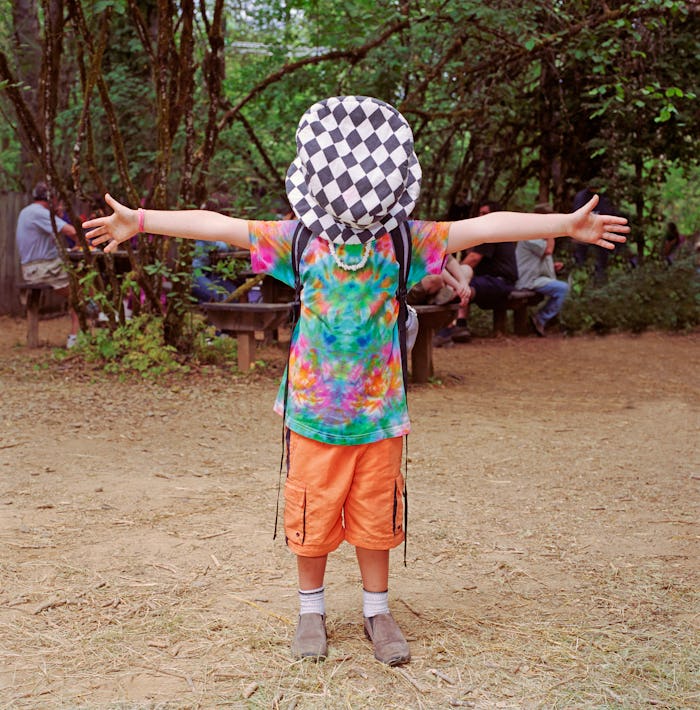Life

Here's The Safest, Easiest Way To Tie Dye With Kids
Let’s say that you’ve just done the laundry and noticed just how many white shirts your family owns. You can either fold that big ol’ pile and put them away — or try out a new craft and tie-dye them. That’s right, tie-dyeing is an awesome way to give new life to formerly white shirts that have now gone slightly grey in color. Plus, tie-dyeing with your children is a really fun way to spend some time together. You’ll just need to know how to tie dye safely with kids first, because, well, chemicals.
Tie dye is entertaining because it doesn’t require a lot of tools or planning. All you really need is an article of clothing (usually a shirt), some rubber bands to crimp and crunch your clothing, and dye... and of course, safety supplies (like kid-sized rubber gloves). “Tie dying is a lot of fun, but it's definitely important to take safety precautions,” fashion expert Laurice Wardini tells Romper. “You also want to learn how to do it correctly to avoid a depressing result.”
Just keep in mind that tie-dying isn’t the cleanest of crafts. In fact, you should probably prepare for a mother of a mess, but that'll make your kids enjoy it even more. Here's how to get started tie-dying for a groovy good time.
1Soak Your Shirt
If you thought that you were going to start the process with a totally dry shirt, think again. “To get the best result, always pre-wash your shirts and then start the tie-dying process while they're damp,” says Wardini. “It's much easier to apply the dye if the shirt is damp.” But damp doesn’t equal dripping wet, so be sure to wring it out before beginning. (Note: A solution made with sodium carbonate, or soda ash, is sometimes used as a pre-soak; however, soda ash is a potential skin and eye irritant which can be poisonous if ingested, according to Healthfully, it's best to use dyes that don't require this step.)
2Use Cotton Shirts
In order to get the best tie dye result possible, it’s best to use 100% cotton shirts, advises Wardini. “Cotton shirts work best with tie-dye because they seem to be brighter and last longer,” says Wardini. If you want to steer clear of cotton, you can always use other natural materials such as linen or hemp, Refinery29 suggested.
3Try Out Natural Dyes
Tie-dying might be cool, but the chemical component might not be. If you’re planning on doing this project with your kids, why not raid your fridge’s fruit and veggie drawer and see what natural dyes you can come up with? “You can create safer plant-based dyes using beets (red/pink), red cabbage (purple), turmeric (yellow), brown onion skins (orange), spirulina (blue), matcha (light green), or chlorophyll (darker green),” advises Wardini.
Juice or boil the produce to get the colored water that you’ll use for tie-dying (or in some cases, like with turmeric and spirulina, you can just mix the powder with water). Boil the fruits and veggies for upwards of an hour (or longer) to get the most vibrant color possible. Plant-based dyes can be safer than chemicals ones, but just require a little more work to make them.
4Practice Safety Protocols
Whether you’re using commercial or plant-based dye, it’s crucial to keep safety at the forefront. “During the process, it's important to wear gloves to keep kids safe,” says Wardini. “I'd also recommend a face mask to prevent breathing in any harmful fumes.” Make sure that the room is well-ventilated, especially if you're using a chemical-based dye. And when it comes to creating the dye, make sure that an adult does it, so that your child doesn’t accidentally splash himself in the eye (in fact, goggles are a good idea) — or worse, try to drink the concoction. You might also consider using a kid-friendly tie dye kit with non-toxic dyes.
5Start Dyeing
You can let your creativity soar when it comes to tie dyeing clothing. By far, rubber bands are a fan favorite when it comes to making patterns and designs. Be sure to have bowls or pots that are big enough to hold the dye water and won’t overflow when you submerge your shirt. “Make sure to get dye in the folds of the shirt too,” says Wardini, and you'll avoid having big blotchy bald spots on your shirt.
6Don’t Peek
Once you’ve dyed your shirt, you might want to unwrap those bands to get a sneak peek at your design. But here’s where patience comes into play. You’ll need to put your shirt in a plastic bag and leave it in there for about eight hours (or overnight) so that the dyes have time to do their magic. After the eight hours have passed, take the shirt out, rinse it under warm water, then run it under cool water.
7 7. Set The Color
Depending on the type of dye that you use, you might need to soak your clothing in something else so that the dyes set well. You can give your tie dye clothing a post-rinse bath in a bucket of vinegar and cool water for about 30 minutes, Hunker reported. The final step: toss it into the washing machine alone and give it a good wash. Let the shirt air dry, and admire your handiwork.
If you’ve exhausted your supply of craft ideas with your kiddo, tie-dyeing can be a new way to create together, bond — and get some cool new clothing to wear, too.
Experts:
Laurice Wardini, fashion expert